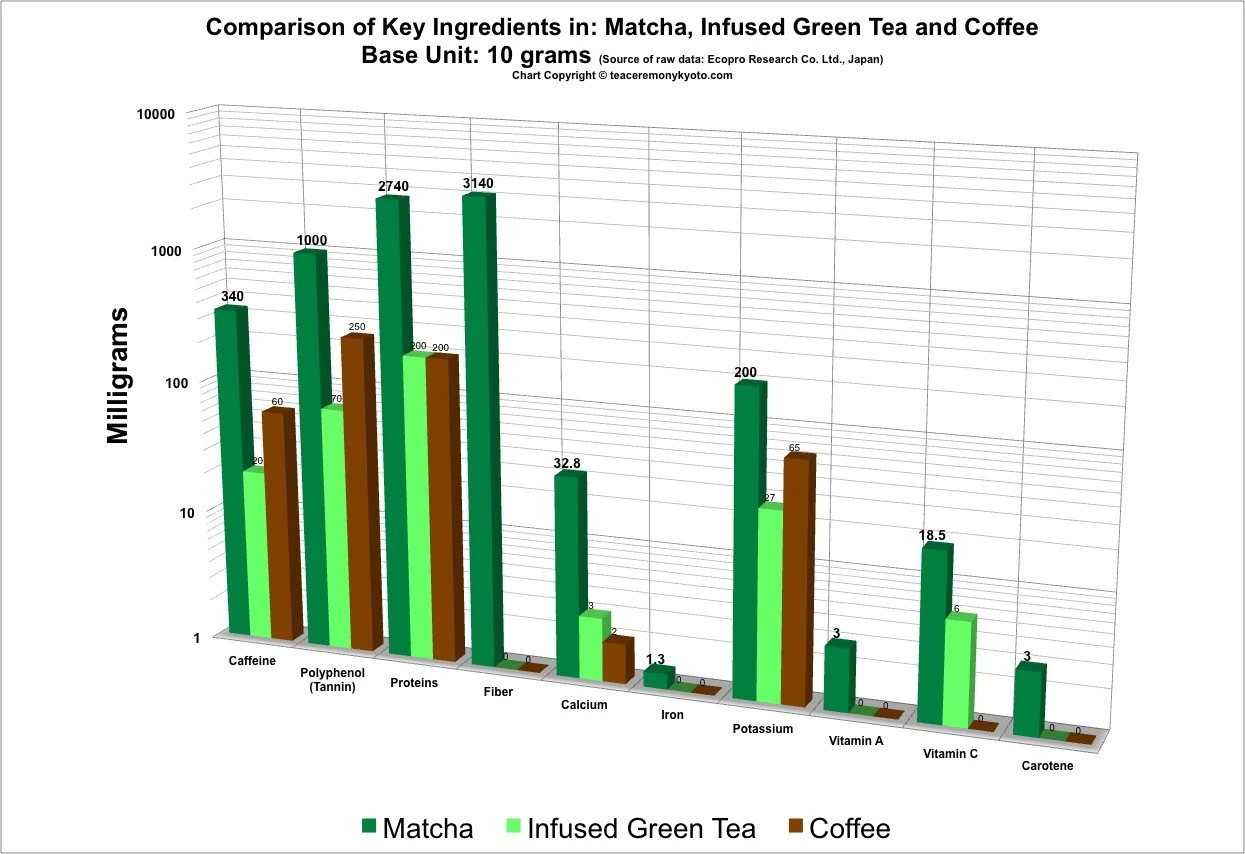Health Benefits of Matcha Tea
Much has been written about the benefits of matcha. The use of simplistic statistics showing the level of antioxidants in matcha compared to other fruits and vegetables, has generated inappropriate understanding, and perhaps led to exaggerated claims as well as a whole new wave of commercial activities around matcha.
Is it all true? The basic facts are true because they are scientifically measured. The way they are presented, however, can often be very misleading. Statistics as a branch of mathematics must be read with the correct understanding and limitations.
For example: the now renown bar chart showing the level of antioxidant measured in a USA lab for 100 grams of matcha, compared to other fruits and vegetables of the same weight, is true. What the reader must not be led to believe is that drinking a bowl of matcha is equivalent to our body ingesting those large amounts of antioxidants. In a bowl of matcha we consume about 2 grams of matcha powder therefore the value used must be reduced by a factor of 50, assuming a linear simplification. Therefore from 1573 we drop down to 31. The meaning of this almost infamous bar chart is that the level of antioxidants ingested in a bowl of matcha made with 2 grams of matcha tea, against the level of 100 grams of spinach or broccoli or blueberries that we ingest is similar.

Obviously, for the same benefits matcha can be said to be a slimmer food because we only need to eat 2 grams of tea leaves powder against 100 grams of another fruit. But this conclusion, taken out of context, can lead quickly to absurd claims about matcha being a potent food for slimming. What we can say is that matcha is a very nutritious drink to take, and it is reasonable to say that it is a potent healthy drink, to use some marketing jargon.
Another aspect of the benefits of matcha is to look at the level of caffeine, vitamins, and proteins in matcha compared to coffee and infused leaf teas. The bar chart shown below or opposite, depending on whether you are reading this article on mobile devices or desktops, brings these other properties into focus. You can click on the chart to view a larger one.
Fibre is an easy one to understand because when you drink matcha you are ingesting a few whole leaves of tea. With infused green tea or coffee, you are not ingesting any fibres. In 2 grams of matcha, therefore, you are ingesting 0.6 grams of fibres against zero grams for green teas or coffee. Remember that the data refers to 10 grams whereas when you drink a bowl of matcha you consume 2 grams, whereas to make tea or coffee you can easily use 10 grams depending on the type of coffee or tea leaves.
Tannins present in teas, according to many scientific reports, indicate a negative association between tea consumption and incidences of cancers. Tea polyphenols and many tannin components are often indicated as being carcinogenic due to their anti-oxidative properties. A 2-gr bowl of matcha therefore guarantees roughly there same amount than in a cup of Italian espresso and much more than infused green tea.
Matcha is also a good source of proteins, about 10 times more than in infused green teas or coffee. Even 2 grams of matcha will contain some 500 milligrams of proteins against 100 milligrams for a 5 grams green tea infusion or 10 grams of coffee.
Matcha is also a good source of calcium; the same cannot be said for infused green teas and coffee because they both contain but a trace
Potassium is another benefit of Matcha: 40 milligrams in a bowl of matcha against 14 milligrams in infused green tea but less than that present in a strong cup of coffee.
Vitamin A is also present in matcha but it is much less present in infused green teas and none at all in coffee. The same applies to Vitamin C for which matcha is a strong source against infused green teas and coffee.
I left caffeine for last because it is believed that although matcha contains more caffeine than coffee itself the way it acts on the body is quite different. Reports indicate that Matcha green tea, because it is prepared as a powder whisked in hot water, the absorption of caffeine by our body occurs over a period of 6 to 8 hours. Unlike the effect of coffee, it is easier therefore on the body and its effect is more mildly distributed over a much longer period of time thus boosting the body metabolism by as much as 40%. One effect of this more gradual absorption is that blood sugar levels are better regulated.
Old Japanese Wives Tale
In the 13th century, Shogun Sanetomo was suffering from heavy headache due to a hangover. Eisai, the Zen monk, recommended him to drink matcha, and he recovered quickly.
If you suspect to have caught the flu, use green tea to gargle when you get home.
If your eyes are tired because of overwork on computers etc., soak a sterile cotton cloth in green tea and put it over your eyes.
Wash your face with green tea and your ageing spots on your face will disappear.
If you suffer with stuffed nose, wash your nose with Bancha and salt.